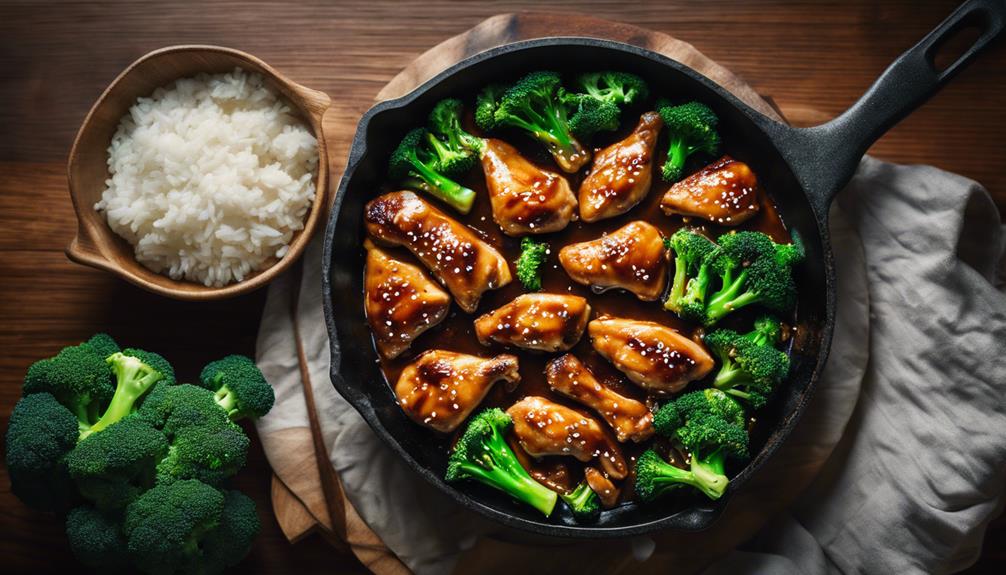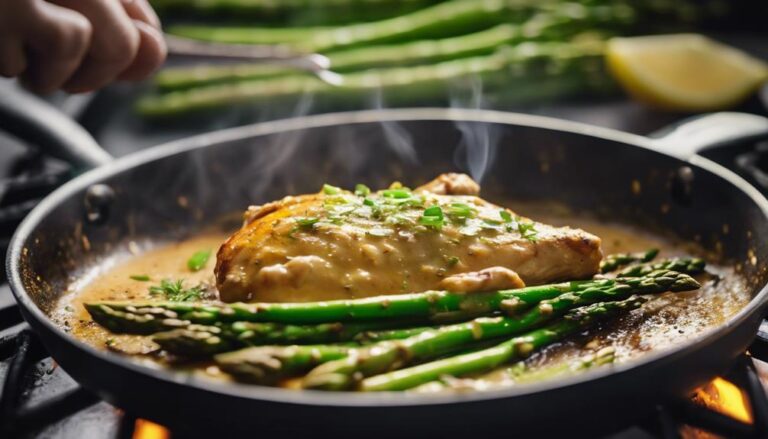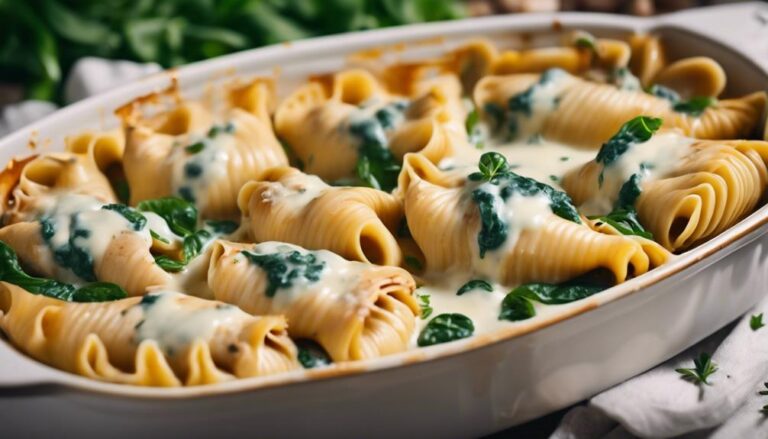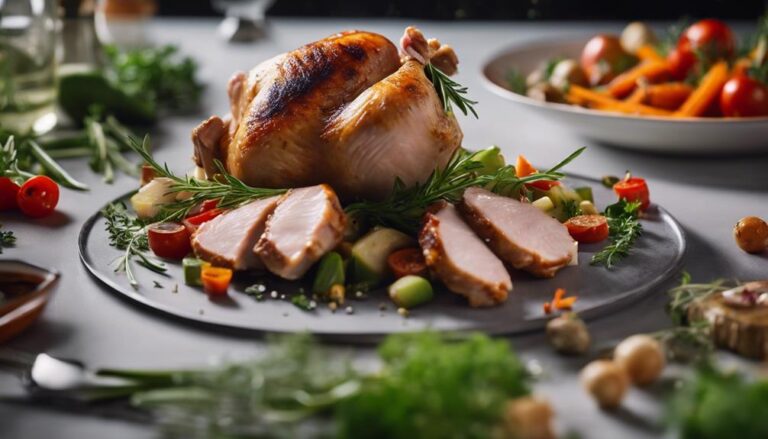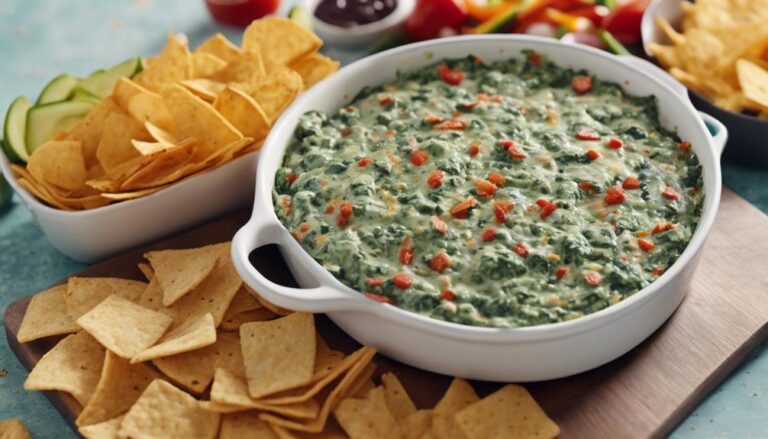Teriyaki Chicken With Broccoli and Rice
Imagine this: tender chicken coated in that sweet, savory teriyaki sauce, mingling with perfectly cooked broccoli and fluffy rice. It's a flavor explosion in your mouth that's gonna make your taste buds dance! Remember, teriyaki sauce is all about that glossy caramelized goodness, and cooking your chicken to 165°F is key. And hey, if you're feeling adventurous, you can swap chicken for tofu or shrimp! Intrigued? There's a whole world of teriyaki deliciousness waiting for you to explore.
What You Will Learn Here
- Teriyaki chicken is a classic Japanese dish with a savory-sweet flavor profile.
- Broccoli adds a nutritious element to the meal, providing vitamins and fiber.
- Rice serves as a staple and complements the teriyaki sauce and chicken perfectly.
- Cooking techniques like grilling or sautéing can be used for the chicken.
- Balancing flavors and textures enhances the overall dining experience.
Teriyaki Sauce Origins
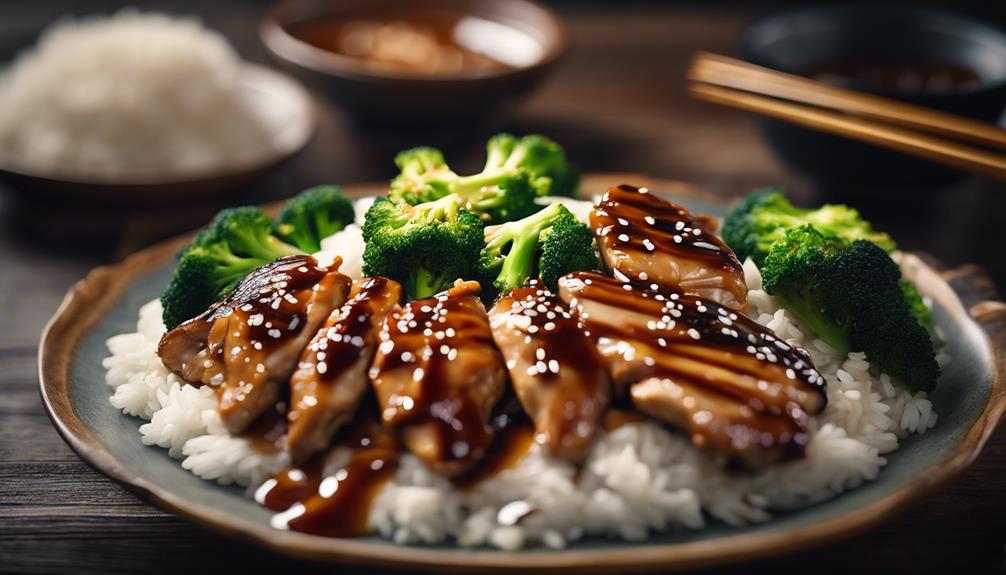
So, you're probably wondering where teriyaki sauce comes from, right?
Well, let's break it down for you. We'll cover the key ingredients that make up this flavorful sauce, explore traditional teriyaki recipes, and even take a peek at how different regions put their unique twist on this classic Japanese condiment.
Ready to sauce things up a bit?
Teriyaki Sauce Ingredients
Exploring the origins of teriyaki sauce ingredients can provide insight into the rich culinary history of Japanese cuisine. Teriyaki sauce, known for its savory-sweet flavor profile, holds deep cultural significance in Japan. The key components of teriyaki sauce typically include soy sauce, mirin (a sweet rice wine), sugar, and sometimes sake.
These ingredients are carefully combined and simmered to create the luscious teriyaki glaze that we all know and love. The cooking techniques involved in making teriyaki sauce require a delicate balance of flavors, with the sugars caramelizing to give that irresistible glossy finish to meats and vegetables.
Traditional Teriyaki Recipes
Traditional teriyaki recipes have been passed down through generations, showcasing the authentic origins of teriyaki sauce. The history of teriyaki chicken is like a delicious tale that unfolds in the kitchens of Japan.
Picture this: succulent chicken, grilled to perfection, and then lovingly coated in a sweet and savory teriyaki sauce that's been perfected over centuries. These recipes come in various forms and variations, each adding a unique twist to the classic dish.
From the tangy notes of mirin to the rich umami of soy sauce, teriyaki sauce flavor profiles are a symphony for your taste buds. Whether you prefer a more sweet-forward sauce or one with a stronger soy kick, there's a teriyaki variation out there just waiting to tantalize your palate.
Regional Teriyaki Variations
In different regions across Japan, teriyaki sauce variations showcase unique flavor profiles that highlight the diverse culinary influences found throughout the country. Japanese cooking techniques play a significant role in shaping these regional teriyaki variations.
From the sweet and savory notes of Kansai-style teriyaki to the more pungent and bold flavors of Tokyo-style teriyaki, each area puts its spin on this beloved sauce. But wait, there's more! Global culinary influences have also left their mark on teriyaki, with modern interpretations incorporating ingredients like garlic, ginger, and even pineapple.
Teriyaki Marinade Components

For a flavorful teriyaki marinade, combine soy sauce, mirin, and ginger in a mixing bowl. Here's a breakdown of what each component brings to the table:
- Soy Sauce: This salty umami bomb is the star of the show, adding depth and richness to your marinade.
- Mirin: A sweet rice wine that balances out the saltiness of the soy sauce, giving your teriyaki that perfect blend of savory and sweet.
- Ginger: Freshly grated ginger brings a zingy and aromatic kick to the marinade, elevating the overall flavor profile.
- Garlic: Crushed garlic cloves provide a robust and slightly spicy note, enhancing the complexity of your teriyaki sauce.
When marinating your chicken, remember to let it chill in this flavorful concoction for at least a couple of hours to allow the ingredients to work their magic. The soy sauce seeps into the meat, the mirin tenderizes it, and the ginger and garlic infuse their aromatic essence. Your taste buds are in for a treat!
Top Teriyaki Chicken Dishes
So, you're ready to step up your teriyaki chicken game?
Well, get ready for some mouthwatering options like:
- Sesame-Ginger Glazed Chicken
- Savory Teriyaki Chicken Thighs
- The delectable Honey-Glazed Chicken Thighs
These dishes will have your taste buds doing a happy dance in no time!
Sesame-Ginger Glazed Chicken
What makes Sesame-Ginger Glazed Chicken stand out among the top Teriyaki Chicken dishes? Well, imagine a delightful blend of Asian fusion and flavorful marinades coming together to create a party in your mouth. Here's why this dish is a real winner:
- Tender Chicken: Picture succulent chicken breast coated in a glossy, sticky glaze that's bursting with savory and sweet flavors.
- Sesame Crunch: Think of crispy sesame seeds adding a delightful crunch to each juicy bite of chicken.
- Ginger Zing: Envision a subtle kick of ginger infusing every morsel with a bright, aromatic zing.
- Balanced Perfection: Imagine a perfect harmony of soy sauce, honey, and ginger dancing on your taste buds, leaving you craving more.
Savory Teriyaki Chicken Thighs
Indulge in the succulent flavors of savory Teriyaki Chicken Thighs, a top contender in the world of Teriyaki Chicken dishes. When you bite into these juicy thighs, you'll be transported to flavor town in a single mouthful.
Here's why you'll love them:
- Grilled Chicken: Imagine those perfectly charred grill marks, sealing in all the delicious juices.
- Stir Fry Recipes: These thighs are so versatile; they play well in stir-fries with vibrant veggies dancing around them.
- Teriyaki Magic: The teriyaki sauce is like a flavor symphony, hitting all the right notes on your taste buds.
- Satisfaction Guaranteed: Whether you pair them with rice or noodles, these thighs will leave you feeling like a culinary genius!
Honey-Glazed Chicken Thighs
Get ready to savor the delectable taste of Honey-Glazed Chicken Thighs, a standout among top Teriyaki Chicken dishes. When you sink your teeth into these succulent thighs, here's what you can expect:
- The honey glaze glistens, inviting you to take that first juicy bite.
- Each tender chicken thigh is perfectly coated in a sticky-sweet goodness that will have you licking your fingers.
- As you chew, the flavors explode in your mouth – a harmonious blend of savory and sweet that dances on your taste buds.
- The golden-brown caramelization on the outside seals in the moist and flavorful chicken, making each bite a heavenly experience.
Prepare for a flavor sensation that will have you coming back for more!
Chicken Cooking Temperature Guide
So, you're ready to whip up some delicious teriyaki chicken, right?
Well, before you get cookin', let's chat about chicken cooking temperatures – we're talking safety first!
Keep your poultry game strong by nailing those safe cooking temperatures with some handy thermometer tips and poultry guidelines.
Safe Cooking Temperatures
To guarantee safe consumption, always cook chicken to the recommended internal temperature as per the Chicken Cooking Temperature Guide.
Food safety is no joke, so let's chat about temperature control. When you're cooking up that delicious teriyaki chicken, make sure the internal temperature reaches a safe level.
For chicken, that magic number is 165°F (74°C). Don't play chicken with undercooked meat – it's not worth the risk!
Using a meat thermometer is like giving your chicken a health check-up; it guarantees you hit the mark every time. So, keep those temperatures in check, and you'll have a meal that's not only tasty but safe to eat.
Thermometer Usage Tips
For accurate cooking, always utilize a meat thermometer to confirm the internal temperature of your chicken reaches the recommended 165°F (74°C).
Remember, the key to perfectly cooked chicken is hitting that sweet spot temperature-wise.
Now, let's talk thermometer accuracy. It's like having your chicken's personal temperature spy. Make sure your thermometer is calibrated correctly for precise readings; you don't want it playing tricks on you.
Think of it as a trust exercise between you and your thermometer – you rely on it for accurate readings, and it promises not to lead you astray.
Poultry Temperature Guidelines
Wondering what temperature you should aim for when cooking chicken to guarantee it's safe to eat? Poultry safety is essential, so let's delve into some chicken cooking temperature guidelines.
The magic number you're looking for is 165°F (74°C). This temperature guarantees that any harmful bacteria lurking in the chicken are sent packing, making your meal not just delicious but also safe to devour.
Now, when it comes to cooking techniques, there are a few options to get your chicken to that perfect temperature. Whether you're grilling, baking, sautéing, or using a slow cooker, make sure to use a meat thermometer to check that your chicken has hit that 165°F mark.
Final Thoughts
Consider these key points before preparing your own version of this delicious teriyaki chicken with broccoli and rice recipe. Reflections on your cooking journey are essential. Did you nail that perfect sear on the chicken? Did the broccoli maintain its vibrant green color? Take a moment to appreciate your culinary skills before diving into the final dish.
When it comes to recipe variations, don't be afraid to get creative! Swap out the chicken for tofu or shrimp for a different twist. Add some pineapple chunks for a sweet and tangy flavor explosion. The beauty of cooking is that you can customize dishes to suit your taste preferences, so feel free to experiment and make this recipe your own.
As you finish up your cooking adventure, remember that the most important ingredient is love. Whether you're cooking for yourself, your family, or your friends, putting your heart into the meal will always make it taste better. So, grab your apron, fire up the stove, and get ready to enjoy a mouthwatering meal of teriyaki chicken with broccoli and rice!
Frequently Asked Questions
Can Teriyaki Sauce Be Made Without Soy Sauce?
If you're pondering about teriyaki sauce without soy sauce, you're in for a treat. There are indeed alternatives to the classic soy-based teriyaki.
You can whip up a soy-free teriyaki by using ingredients like coconut aminos, tamari, or even a splash of balsamic vinegar for that tangy kick.
How Can I Prevent My Chicken From Becoming Tough?
To keep your chicken tender, try not overcooking it. Choose the right meat, like chicken thighs, which are more forgiving than chicken breasts.
Marinating your chicken can also help. Don't forget to control the cooking temperature—no need to blast it with high heat.
These little tweaks in your cooking techniques can make a big difference in preventing your chicken from turning into a chewy workout for your jaw!
What Are Some Alternative Vegetables for This Dish?
Looking to mix up your stir-fry game? When it comes to Asian fusion recipes, the veggie world is your oyster!
Instead of broccoli, consider snap peas for a sweet crunch or water chestnuts for a bit of texture.
For a spicy twist, throw in some bell peppers or even bok choy.
Get creative with your stir-fry variations and watch those flavors pop!
Can I Use a Different Type of Meat for Teriyaki?
You're looking to switch up your teriyaki game and wonder if you can swap the meat. Absolutely! Meat alternatives for teriyaki are plentiful. Think pork, beef, tofu, or even shrimp for a tasty twist. Each brings its own unique flavor to the table.
Experiment with different meats to find your favorite combo. Cooking techniques and recipe variations can vary based on your meat choice, offering a world of delicious possibilities to explore!
Is There a Low-Sodium Teriyaki Sauce Option Available?
Looking for low-sodium alternatives in the sauce department? Absolutely! You can find some teriyaki sauces on the market that are lower in sodium.
Keep an eye out for options labeled as 'reduced-sodium' or 'low-sodium' for a healthier choice. Don't worry; these alternatives still pack a punch in the flavor department, so you won't miss out on that delicious teriyaki taste.
Enjoy experimenting with different flavor options!
Conclusion
So there you have it, folks! Teriyaki chicken with broccoli and rice isn't only delicious, but also packed with flavor and nutrients.
Remember to cook your chicken to the right temperature to avoid any kitchen mishaps.
Now go impress your friends and family with your newfound teriyaki skills, and enjoy a tasty meal that will have everyone coming back for more.
Happy cooking!
